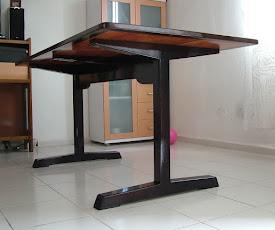When I saw
this project in Popular Woodworking Magazine I knew I had to build it. It is under the
"I Can do That" seccion, it's an easy project. In fact, it's
too easy for me, no challenge, no new technique, but I liked the design, it's a cute step-stool for my
daugther. So, what the heck... let's build it.
.
STEP STOOL
.
.
.
A couple of years ago a
mahogany tree was felled because an hurricane at a parcel that belong to my friend Oscar. He cut the log into manageable sections and ask me to take it away from his yard. I was happy to get wood for free. I'm not skilled to use a chainsaw but I did my best.
.
.
I know there are simplest ways to flatten a board, but I already have this sled, and I'm used to use it. I can get dead-flat boards without any fuss.
After one face gets flattened, I turn it over and pass it again trough the thicknesser planer without the sled.
.
.
I recently bought digital version of
Handplane Essentials by Christoper Schwarz. What a
great book!, I am learning a
LOT so I'm starting to use my handplanes more
often. Here I'm
straightening one edge. The sound of a well tuned handplane is unique.
.
.
Once the faces and one edge are true I simply use my table saw to rip the board to width. Yes, I know, I know, it's a small benchtop table saw... I have an eye on a bigger tablesaw, from Makita... but I'm just dreaming...
.
.
This is what the boards looks like after rough cut. Dimensions are not final. I Usually do the rough cut 1/8" or 1/4" oversized on the table saw. This time I had a lot of leftover lumber (marked with an "X")
.
.
For this project I go the easy way. I trim my workpieces to final width by using my thickness planer. My workpieces will match their exact width with ease, but the edges probably won't be perfectly squared, in this particular project that doesn't matter.
.
.
Quick and easy: I cut to final length on my miter saw. Piece of cake.
.
.
When all my workpieces are on final dimensions, I cut a roundover on every posible edge. This is also a piece of cake on my router table. Have you noticed the router lift mechanism?
.
.
For this project I needed two dowels 30" long. I already have dowels in my workshop, but their diameter was a bit larger than 1". Go to downtown to buy new dowels was not an option, I'm sure I would have had a very similar crap. In order to fix the dowel I came up with this quick and simple sort of "lathe". I turn on the hand drill with one hand, and use the other hand to rub a sandpaper against the dowel. I find this kind of experiments very funny. It's good to have a wagon vise in my workbench.
.
.
I applied dye on the dowels, then glue up the thing.
.
.
Just to have more fun in this project, and for better look, it ocurred to me to use wood plugs as an easy and attractive way to hide screw head. I decided to use a very contrasting wood: Ziricote. This time I'm going to shut up and let the pictures speak for themselves:
.
.
.
.
.
.
.
.
.
My daugther, Noelia, approved my work.
.
.
.
Nos vemos luego!!!




























































Hola amigo, he estado siguiendo tu blog durante varios dias, desde que lo descubri no he dejado de leerlo, tambien he demorado en leerlo porque no entiendo mucho el ingles jaja.
Una pregunta, la broca que usas para hacer los "taquete" donde la conseguiste? requiero una.
Te agradecere tu ayuda.
Saludos!!